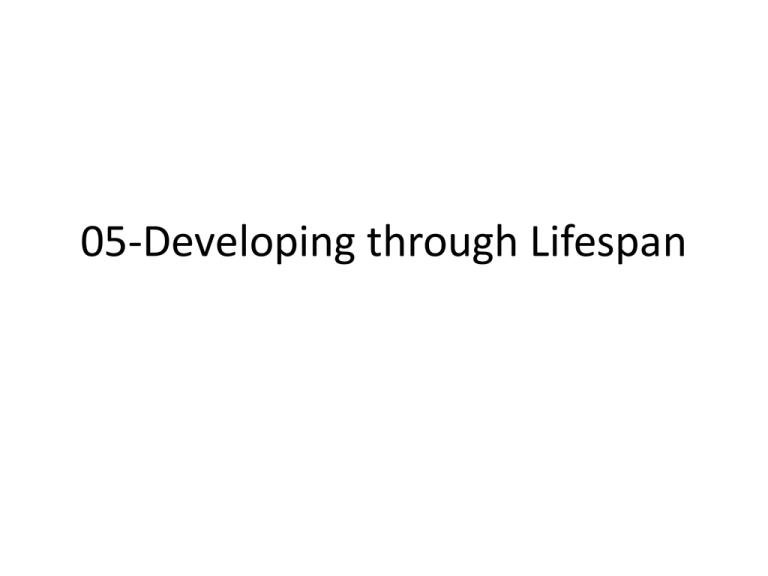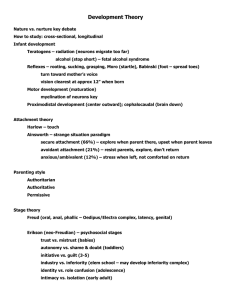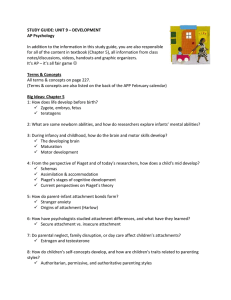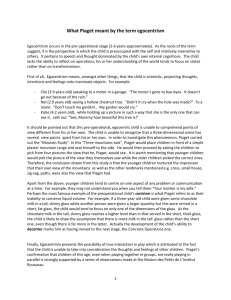05-Developing through Lifespan
advertisement

05-Developing through Lifespan What do you want to do before you die? Class presentation video: Development What topics do you need help with? What topics do you need help with? • • • • • A. Piaget’s stages of cognitive development B. Effects of different types of parenting C. Effects of a positive self concept D. Kohlberg’s stages of morality E. I understand What topics do you need help with? • • • • • A. Symptoms of Alzheimer's disease B. Fluid intelligence VS crystallized intelligence C. Social clock D. Predictors of marital satisfaction E. I understand Cell differentiation begins when the prenatal organism is a(n): A. B. C. D. zygote. fetus. embryo. single cell. Cell differentiation begins when the prenatal organism is a(n): A. B. C. D. zygote. fetus. embryo. single cell. Two closed, pyramid-shaped beakers containing clearly identical amounts of a liquid are suddenly judged by a child to hold different amounts after one of the beakers is inverted. The child apparently lacks a: A. B. C. D. sense of object permanence. concept of conservation. capacity for habituation. secure attachment. Two closed, pyramid-shaped beakers containing clearly identical amounts of a liquid are suddenly judged by a child to hold different amounts after one of the beakers is inverted. The child apparently lacks a: A. B. C. D. sense of object permanence. concept of conservation. capacity for habituation. secure attachment. Jack is learning to understand algebra. He loves to discuss philosophical issues with his friends, and is exploring various religious beliefs. Jack is in Jean Piaget’s __________ stage. A. B. C. D. preoperational sensorimotor formal operational concrete operational Jack is learning to understand algebra. He loves to discuss philosophical issues with his friends, and is exploring various religious beliefs. Jack is in Jean Piaget’s __________ stage. A. B. C. D. preoperational sensorimotor formal operational concrete operational After Nadia learned that penguins can't fly, she had to modify her existing concept of birds. This best illustrates the process of: A. B. C. D. conservation. assimilation. habituation. accommodation. After Nadia learned that penguins can't fly, she had to modify her existing concept of birds. This best illustrates the process of: A. B. C. D. conservation. assimilation. habituation. accommodation. Although 3-year-old Adam happily explores the attractive toys located in the dentist's waiting room, he periodically returns to his mother's side for brief moments. Adam most clearly displays signs of: A. B. C. D. secure attachment. object permanence. egocentrism. stranger anxiety. Although 3-year-old Adam happily explores the attractive toys located in the dentist's waiting room, he periodically returns to his mother's side for brief moments. Adam most clearly displays signs of: A. B. C. D. secure attachment. object permanence. egocentrism. stranger anxiety. "I don't care whether you want to wash the dishes, you will do so because I said so!" This statement is most representative of a(n) ________ parenting style. A. B. C. D. preconventional authoritative formal operational authoritarian "I don't care whether you want to wash the dishes, you will do so because I said so!" This statement is most representative of a(n) ________ parenting style. A. B. C. D. preconventional authoritative formal operational authoritarian According to Erik Erikson, the task of the adolescent is to: A. B. C. D. find intimacy. establish an identity. become autonomous. conquer their sense of inferiority. According to Erik Erikson, the task of the adolescent is to: A. B. C. D. find intimacy. establish an identity. become autonomous. conquer their sense of inferiority. Marissa resents the burden and constraints of caring for her infant daughter and frequently ignores her cries for attention. As a consequence, her daughter is most likely to display signs of: A. B. C. D. egocentrism. accommodation. insecure attachment. habituation. Marissa resents the burden and constraints of caring for her infant daughter and frequently ignores her cries for attention. As a consequence, her daughter is most likely to display signs of: A. B. C. D. egocentrism. accommodation. insecure attachment. habituation. John’s two-year-old twins are constantly fighting over toys. This behavior is driving John crazy because the twins are hitting each other and pulling toys from each other. He decides to have a talk with them to explain that their behavior has to change. He tells each of them that the other one feels bad when being hit and that they should learn to share. Continued on next slide Continued from previous slide To his dismay, the behavior continued as if he hadn’t done anything. According to Jean Piaget, why might this be happening? A. Two-year-olds are egocentric and cannot understand things from another’s point of view. B. His children are simply misbehaving and stronger punishment is required. C. During this age children are learning conservation and they are trying to get all the toys for themselves. D. Sibling rivalry cannot be controlled. It is just a phase. Continued from previous slide To his dismay, the behavior continued as if he hadn’t done anything. According to Jean Piaget, why might this be happening? A. Two-year-olds are egocentric and cannot understand things from another’s point of view. B. His children are simply misbehaving and stronger punishment is required. C. During this age children are learning conservation and they are trying to get all the toys for themselves. D. Sibling rivalry cannot be controlled. It is just a phase. Marissa resents the burden and constraints of caring for her infant daughter and frequently ignores her cries for attention. As a consequence, her daughter is most likely to display signs of: A. B. C. D. egocentrism. accommodation. insecure attachment. habituation. Marissa resents the burden and constraints of caring for her infant daughter and frequently ignores her cries for attention. As a consequence, her daughter is most likely to display signs of: A. B. C. D. egocentrism. accommodation. insecure attachment. habituation. Three-year-old Jorge sees his sister Isabel put on their father’s big boots and walk around outside in the fresh snow. Isabel asks Jorge, “When mommy comes home and sees the footprints, who will she think was walking around in the snow outside?” Jorge will reply, A. B. C. D. “Daddy!” “Mommy!” “Me!” “You!” Three-year-old Jorge sees his sister Isabel put on their father’s big boots and walk around outside in the fresh snow. Isabel asks Jorge, “When mommy comes home and sees the footprints, who will she think was walking around in the snow outside?” Jorge will reply, A. B. C. D. “Daddy!” “Mommy!” “Me!” “You!” • Heinz story: In Europe, a woman was near death from a special kind of cancer. There was one possible drug that might save her, and it was made by a specific druggist who charged 10 times what it cost to make the drug. The woman’s husband, Heinz, tried to borrow money, get a loan, and sell assets, but he couldn‘t pull together enough money to pay for the drug. He went to the druggist and asked if the druggist would sell the drug for a lower price or if the druggist would let him pay off the drug over time. The druggist refused, and demanded full payment before he would give the drug to Heinz. Having exhausted all possible means of getting the drug legally, should Heinz break into the druggists store, and steal the drug? What do you think? Should Heinz steal the drug? (also come up with a reason why or why not) A. yes B. no Copyright © Allyn & Bacon, 2009 If you said “yes”, which of the following most closely aligns with your thinking? He should steal the drug because… A. he can get away with it B. others will look down on him if he lets his wife die C. the protection of human life is a higher moral principle that can overrule laws against stealing Copyright © Allyn & Bacon, 2009 If you said “no”, which of the following most closely aligns with your thinking? He should not steal the drug because… A. he might get caught B. it is against the law C. doing so violates a basic social contract needed to preserve civilization: you should not steal Copyright © Allyn & Bacon, 2009 Comparison People who said YES A. preconventional B. conventional C. postconventional Copyright © Allyn & Bacon, 2009 Comparison People who said NO A. preconventional B. conventional C. postconventional Copyright © Allyn & Bacon, 2009 Discussion Question Using specific examples, differentiate between the thinking patterns of a 3-year-old preschooler and a 9-year-old student, according to Piaget's theory of cognitive development. • • Response correctly describes that the preschooler is in Piaget’s preoperational stage and correctly describes various examples from the preoperational stage including the core idea that the preschooler is unable to perform operations (or to think logically), such as: thinking abilities that the child can do – – – • or limitations of children’s thinking – – – • • • • • • using symbols to represent world engaging in make-believe play asking lots of questions to find out information Egocentricism inability to conserve irreversible thinking. Response also correctly describes that the 9 year-old is in Piaget’s concrete operations stage and correctly describes various examples from the concrete operations stage including the core idea that the 9 year-old cannot think abstractly (or has concrete thinking), such as: less egocentrism centration no longer occurs capable of conservation capable of reversible thinking




